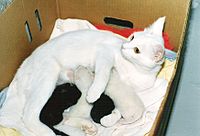
Photo from wikipedia
Lipopolysaccharide (LPS) and lipoteichoic acid (LTA) are cell wall components of Escherichia coli and Staphylococcus aureus, which cause clinical and subclinical mastitis, respectively. However, the reason of the difference in… Click to show full abstract
Lipopolysaccharide (LPS) and lipoteichoic acid (LTA) are cell wall components of Escherichia coli and Staphylococcus aureus, which cause clinical and subclinical mastitis, respectively. However, the reason of the difference in symptoms by pathogen type remains unclear. In this study, the influence of LPS and LTA on early response and milk production in lactating bovine mammary epithelial cells (BMECs) was comparatively investigated. The results showed that LPS decreased the secretion of β-casein, lactose, and triglycerides, whereas LTA decreased the secretion of lactose and triglycerides but increased lactoferrin production without any influence on β-casein secretion. In addition, the influence of milk lipid droplet size in BMECs and gene expression related to milk fat synthesis was different between LPS and LTA. LPS increased the gene expression of interleukin (IL)-1β, tumor necrosis factor-α, and IL-8 through the activation of the nuclear factor-κB (NF-κB), p38, and c-Jun N-terminal kinase pathways, whereas LTA increased IL-1β and CC chemokine ligand 5 expression through the activation of the NF-κB pathway. Moreover, these cytokines and chemokines differently affected the milk production ability of BMECs. These results suggested that the pathogen-specific symptoms may be related to the differences in the early response of BMECs to bacterial toxins.
Journal Title: Experimental cell research
Year Published: 2021
Link to full text (if available)
Share on Social Media: Sign Up to like & get
recommendations!